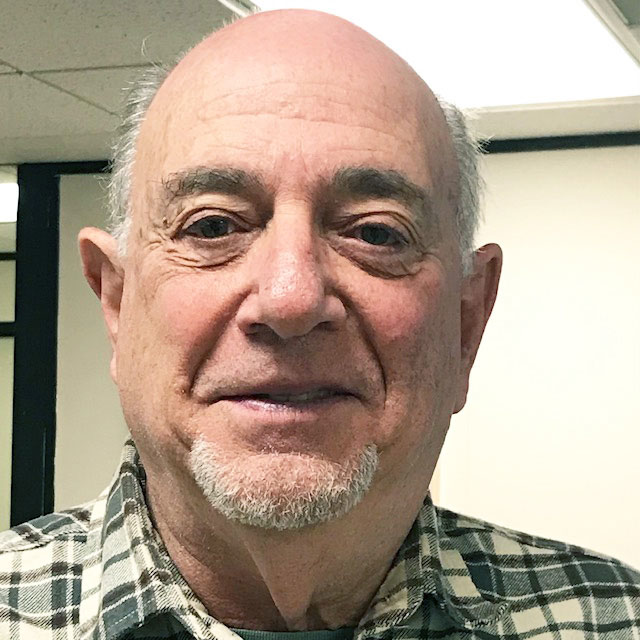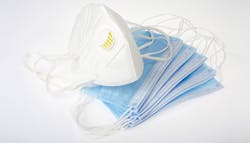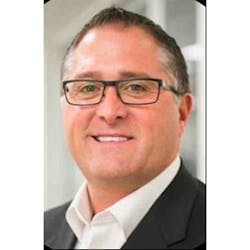Pandemic reveals new concerns about facial protection products
When it comes right down to fighting the spread of any airborne-transmitted respiratory viruses, people generally have three ways to protect themselves: Get vaccinated, disinfect the air or cover your face – mouth and nose specifically.
Each of the three raise the hackles of some interest group with the overarching opinion being something akin to “don’t tell me what to do if it’s costly, inconvenient and may infringe on freedom, privacy or religious beliefs.” During the last two years or so, air disinfection strategies and tactics drove interest and growth in ultraviolet radiation delivered through lighting products and premium air filters.
People didn’t need an airborne respiratory pandemic to learn about covering their mouths and noses because children tend to – or should be – taught to cough or sneeze into their hands or the inside crux of their elbows. With an airborne respiratory pandemic, however, you likely don’t want to walk around covering your face with your hands or arms. That’s where masks, respirators and shields enter the scene.
During the last two-plus years people learned quite a bit about face coverings, including access, comfort, durability and fit. The most affordable models tend to be disposable, single-use-only textiles that must either be replaced – or in the case of desperation, the Food and Drug Administration gave details on how to clean, disinfect and sterilize for limited reuse enroute to replacement. Other products, like respirators, were molded from harder materials or required attached filters to be changed. Reusable face shields, molded with clear plastic materials attached to a plastic frame, needed to be cleaned, disinfected and sterilized routinely.
For masks and respirators, comfort and convenience posed problems as they needed to be fitted properly and tended to pull on the wearer’s ears. Further, they generally obscured facial expressions during conversations, which created challenges for children and the mentally and sensory disabled who must see facial expressions and read lips. Finally, they all needed to be approved or cleared by FDA via NIOSH.
The global pandemic years of 2020-2022 should have taught suppliers (e.g., manufacturers and distributors) and providers (e.g., hospitals and other healthcare organizations) about how to prepare for the next airborne respiratory virus, whether any outbreak becomes endemic or pandemic. What, in fact, did everyone learn?
Schooled by crisis
Lessons learned by suppliers and providers during the COVID-19 pandemic should lead to dramatic changes in product design and process workflow over time. The amount of time, however, remains in question.
The pediatric segment raised considerable concerns for Jason Burnham, Senior Director of Facial Protection, Owens & Minor.
“One of the biggest challenges was in regard to children’s masks, or the lack thereof,” Burnham declared. “Currently, the FDA does not recommend N95 [respirators] for children – leaving parents and healthcare workers uncertain about how to protect their children’s health. While some manufacturers offer a small respirator, they are not designed nor tested to be worn by children. Children need masks that are not only sized appropriately for their face, but that also provide the filtration needed to help protect them – an opportunity that is certainly worth exploring further with research and design.”
Burnham warns against moving on from making improvements as the healthcare industry heads into COVID-19’s “endemic” phase.
“Even as COVID-19 cases decline and PPE is readily available, we continue to see use of facial protection that is not aligned with recommendations from health agencies and authorities or product IFUs (instructions for use),” he noted. “Since the inception of the pandemic, staff are often re-wearing disposable face masks due to scarcity rather than disposing and donning a new mask between patients. This is a significant departure from the CDC’s Standard Precautions, a set of infection prevention practices first developed in 1996 designed to protect both healthcare workers and patients from the spread of infections. The CDC’s Standard Precautions and Isolation Precautions emphasize removing and discarding PPE before leaving a patient’s room.”
As trending evidence of pandemic-relaxed behaviors morphing into workflow acceptance, Burnham cited a recent 2022 study conducted by Owens & Minor that found that 40% of respondents, including surgeons and surgical support, said they were re-wearing masks due to habits that began during the pandemic.
“During the pandemic, the reduced supply of facial protection led healthcare workers to wear whatever type of facial protection that was available even if it didn’t match the protection needed in certain settings – oftentimes causing them to wear more or less protection than required,” Burnham continued. “Now that supply of facial protection is healthy, staff should return to choosing the right mask with the level of protection needed for the task at hand to rebalance proper product demand planning. For instance, if entering a setting where there is a high risk of splash, an ASTM Level 3 mask should be selected rather than a Level 1 mask.
“Additionally, scarcity of eye, nose and full-face protection led many healthcare workers to find makeshift solutions or to reuse contaminated protection devices meant for single use,” he said. “CDC Standard and Isolation Precautions previously established the importance of using masks with attached shields, face shields and/or eyewear in patient interactions where fluid splash or aerosol-generating procedures might create risk of eye, nose, mouth, or face contamination.”
Time to retighten the rules?
Some contend that once the FDA issued “emergency use” guidelines for PPE to accommodate product shortages, alleviate panic buying and prevent desperate decision-making without a designated endpoint or strict policy of returning to standard precautions the federal agency, by and large, enabled a “put the genie back in the bottle” situation.
“Masks, shields, and especially N95s are designed for single-use and to be worn for a limited time, but now they’re being worn all day,” lamented Gary Harris, Vice President Sales and Marketing, Prestige Ameritech. Prestige Ameritech has focused [product design] on skin sensitivity, comfort and durability … in this new environment. The entire industry needs to accommodate this shift in product usage.”
Still, Harris hopes the FDA steps in to help providers get back on track.
“We agree that the emergency use measures will continue in a significant number of facilities unless the FDA takes action to stop it,” he told Healthcare Purchasing News. “Two things come into play: One is the longer they use the product, the fewer products you will need so the healthcare systems are incentivized to use the products longer than their original design to save money. Second factor is that the healthcare providers are becoming accustomed to wearing products longer as opposed to changing masks each time between patients. In some cases, the mask is worn all day long. Overtime the healthcare provider thinks that wearing a product all day long is normal.
“This paradigm shift will not go away anytime soon,” Harris warned, “and so manufacturers need to understand this and adapt to making design changes and improvements to accommodate this shift. As it is prudent for the protection of the healthcare provider, when dealing and interacting with the patients, single-use products should continue to be the norm. Reprocessing of some products is acceptable under specific conditions, but with N95s this is not proven to be a successful strategy.”
Addressing complications
Comfort, fit and facial communication continue to complicate extended wearing of masks, respirators and face shields, according to experts.
Michelle Schwebel, RN, Senior Director of Product Development, S2S Global, (a direct sourcing wholly owned subsidiary of Premier Inc., concurred that comfort is key.
“Our market assessment showed that comfort is the No. 1 criterion for healthcare workers when selecting a mask,” Schwebel said. “Pre-pandemic, many suppliers (including PremierPro via S2S Global) offered a broad assortment of ear loop and surgical tie designs to help ensure the ‘right mask for the right case.’ Post pandemic, buyers have trended purchasing toward one or two ear loop masks. We have reintroduced a broader – but still focused portfolio – of comfortable masks we feel will go a long way in improving user satisfaction, safety and give purchasers a sense of ownership of their selection.”
Comfort should accompany fit, according to Medline’s Chua.
“It is also critical that healthcare workers pass a fit test,” he said. “An N95 mask should be fitted annually or when they use a new respirator. If they do not pass a fit test, they should not use that N95. This requires coming up with alternative options, such as powered air-purifying respirators (PAPRs).”
Facilitating facial communication may be causing another product design shift going forward.
“Something that was more prominent during the pandemic is the ability for a physician and patient to create human connection or read lips,” Chua noted. “You have people with disabilities or who are hard of hearing, or really they just need that lip reading as an extra tool for them. Creating that connection and being able to see your physician’s face is really helpful. Some solutions that are becoming more popular on the market include clear masks or powered air-purifying respirators (PAPRs) that have that clear shield in front.”
Tracking inventory, origins
Consequently, Chua encourages providers to pay close attention to product development.
“Keeping up with the latest advances in respiratory protection technology is critical to helping staff, patients and residents stay safe,” he advised. “Understanding the differences between the most common devices and ensuring that healthcare workers can access and wear them properly are key to preventing the spread of healthcare-associated infections (HAIs).
“Additionally, working with your supply vendor can help a healthcare organization be more of their inventory levels and be prepared for future public emergencies. Knowing in advance what your needs are will allow more time to work with a supply vendor to identify the right solution,” he added.
Owens & Minor’s Burham recommends keeping track of what’s in stock and available for immediate use.
“While it is important to have a safety stock of facial protection, facilities should review the product they have on hand to assess if it truly meets their needs in quality and product mix,” he said. “Healthcare professionals should review the products and take note of their expiration date, if they are clinically acceptable, tested to meet ASTM standards and if they are FDA 510(k) cleared. As a recent example, a hospital had a large supply of ear loop masks on hand. However, when they began assessing their stockpile of ear loop masks, they realized that the masks were tight and did not comfortably fit staff, nor did they meet ASTM standards.”
Product origin matters, too, according to Burnham, particularly due to logistics and transportation issues suffered by supply chain operations during the last two years.
“Today, healthcare organizations should have a healthy supply of facial protection products,” he indicated. “As they assess long-term partners, it is important for them to understand where their product originates from. Providers should ask suppliers where their raw materials come from and where they are manufactured with questions like – does the fabric from the mask originate from overseas or is it made domestically? Or are the components assembled domestically or overseas and then shipped to the U.S.? This can support better planning for potential industry supply challenges in the future. Organizations should also consider the depth and breadth of the supplier’s portfolio, ASTM levels offered and if the products have received 510(k) clearances. Having a domestic product isn’t helpful unless the product meets the quality standard as well.”
Prestige Ameritech’s Harris emphatically supports and promotes American-made products as superseding price.
“Don’t make price the deciding factor, but instead whether your PPE comes from a domestic manufacturer or not,” he urged.
“Domestically produced products in general are more expensive than products from some areas of the world,” Harris acknowledged. “When it comes to protective apparel, particularly in facemasks and respirators, the cost differential is just a few pennies. This additional cost should be measured against the result of providing inferior protection to the healthcare providers and patients, and in many cases, as we saw in the pandemic, no protection whatsoever. The question gets down to whether an institution is willing to pay a few cents more to have a solid, guaranteed supply of quality product for their workers or if that few pennies is worth risking infection, supply issues and lack of adequate protection for their workers. We had customers during the pandemic who chose to purchase less expensive products from overseas suppliers and many of these customers were provided with products that offered subpar quality at best – if they even showed up.”
S2S Global’s Schwebel recognizes that as the pandemic regresses into more of an endemic and supply channels refill with product, healthcare organizations should be able to return to more stringent practices and precautions.
“With supply of masks no longer strained, changing masks between patient visits can help reduce the risk of cross contamination across situations,” she noted. “Long-term use of the same face mask can also result in a hot or humid feeling that can result in skin irritation and general discomfort. Frequent changing of face masks helps to increase comfort by keeping the space around users’ nose and mouth clean and dry.”
Schwebel encourages informed purchasing and use.
“When possible, grab a mask that has foam across the nosepiece. This foam is designed to reduce fogging of eyewear, but it also goes a long way in providing both a comfortable feel and snug fit to the mask,” she said. Masks with attached visors are a great way to protect the mucous membranes of the eyes in addition to the nose and mouth of a wearer. These mask designs can provide all-in-one protection and ensure eye protection is not forgotten.”
Sources:
https://www.cdc.gov/coronavirus/2019-ncov/prevent-getting-sick/about-face-coverings.html
https://www.cdc.gov/oralhealth/infectioncontrol/summary-infection-prevention-practices/standard-precautions.html)
https://www.cdc.gov/infectioncontrol/guidelines/isolation/index.html
https://pubmed.ncbi.nlm.nih.gov/29262198/
What did COVID-19 teach providers about facial product design?
Against the backdrop of what was learned during the 2020-2022 global pandemic and supply chain disruptions, what are some relevant and useful capabilities and features for manufacturers to incorporate in “redesigned” or “updated” mask, respirator and shield products? Experts share their thoughts.
“A number of improvised innovations surfaced during the pandemic, from different mask attachments for comfort and fit to visibility modifications for easier communication. While a number of these creative ideas emerged out of necessity from healthcare workers on the front lines and were uniquely driven by unusual work conditions in the pandemic environment, some learning from these home-grown innovations will likely find their way into regular features and benefits as the pandemic recedes and as manufacturers apply research and development assessment to these insights from front line healthcare workers.”
Jason Burnham, Senior Director of Facial Protection, Owens & Minor
“We are seeing a shift toward reusable solutions to protect inventory levels and also complement sustainability initiative to reduce waste and lower costs. Reusable PAPRs [powered air-purifying respirators] became more popular when the pandemic started as they can be wiped down and are resilient and efficient in their shape and mobility.
“Medline introduced a PAPR to its product portfolio last year called the PureFlo 3000. Most PAPRs have an attached hose and belt. Ours is fully head-borne to increase mobility and to make it easier to don and doff, and does not require fit-testing.
“As we continue to think about product development, the following are a few factors we’re looking at:
- “Comfort as long-term use becomes more common
- “Sustainability: We are looking at the environmental impact of our masks and respirators and thinking about how we can produce greener PPE.
- “Accommodating patient backgrounds and figuring out how we can create PPE that caters to people who need to read lips or cannot shave their beard for religious reasons and therefore cannot wear an N-95 mask.”
Mark Chua, Vice President of Preventive Care, Medline Industries
“PPE are life saving devices and cannot be chosen on price alone. These products should be purchased from a domestic manufacturer that utilizes domestic raw materials. Otherwise, supply is controlled by foreign countries.”
Gary Harris, Vice President Sales and Marketing, Prestige Ameritech
“Manufacturers today are focusing on enhancing comfort wherever possible, including through the use of innovative fabrics that offer adherence to ASTM standards while still being cool and comfortable. Driving comfort in this space without sacrificing quality and protection helps increase compliance and can make life better for healthcare workers.
“Additionally, our suppliers are focused on reducing their environmental footprint, and mitigating waste is at the forefront of future development initiatives. While single-use products still represent the best foot forward for infection prevention and control, manufacturers of single-use products are working hard to find ways to reduce their impact on the environment and doing so through multiple initiatives both directly related to product design and development and overall, with their organizational efforts.”
Michelle Schwebel, RN, Senior Director of Product Development, S2S Global, a direct sourcing wholly owned subsidiary of Premier Inc.
Healthcare resistance to wearing facial protection must be alleviated

Roger Machson
“The premise that healthcare workers reject wearing protective gear is one of the biggest problems we face today,” said Machson, President, Onyx Medical Inc., which manufactures facial protection products sold through distributors. “Many, if not most airborne transmissions are a result of sneezing and or close contact with aerosol from infected individuals. Contamination and infections are a result of liquid droplets and airborne virus. In order to be effective in combating transmission of a virus, the best approach is one that addresses all means of exposure. Just concentrating on airborne alone and ignoring exposure of liquid droplets is an ineffective approach to combat the spread of virus infections.”
Machson questions how ultraviolet radiation may be used.
“Ultraviolet radiation does not directly address face to face contact,” he said. “Ultraviolet is only effective in keeping random airborne virus from migrating, leading us to ask what other solutions are available. Let’s start with the original blood-borne pathogen regulations. These regulations were meant to protect healthcare workers from the effects after the discovery of [HIV] the AIDS virus. This virus was a death sentence if contracted. It was the hospital’s/employer’s responsibility to provide and protect the healthcare worker under penalty. Why, and how has this changed over time?
“The healthcare worker refusing to wear protective gear against viral contamination can only be justified if the protective gear is ineffective. Many of the current arguments against wearing protective gear would be diminished if the gear protected well and was comfortable to wear without interfering with the users’ job description. This baseline of effectiveness is subjective and difficult to quantify. Common sense tells us that the more complete the barrier between a healthcare worker and the contamination source, the better the outcome is for all involved.
“As a starting point for basic protective gear, we can start with the simple mouth mask. Surgical masks can provide decent viral protection if well sealed around the nose and mouth. However, they leave both the eyes and skin exposed and open as potential ports of entry. Masks used in conjunction with a simple full-face shield provide additional protection. The biggest problem with this is the quality of anti-fogging on the face shield. Most inexpensive shields are poor quality with regard to anti-fogging. Due to poor vision quality, people don’t want to wear them. If the anti-fogging is good, the shield becomes an improvement.
“Reusable shields with plastic frames have a number of issues to consider. First is comfort. Plastic frames tend to be uncomfortable due to rigidity and use of hard plastic. The soft, pliable, medical grade head piece foam that holds a shield against the forehead is gone. Next, reusable shields are hard to clean correctly. Many anti-fogged shields lose their effectiveness when sprayed or cleaned. The anti-fog solution originally sprayed on a plastic sheet can wipe off during cleaning mitigating usefulness in subsequent uses. Cleaning a shield after potential contamination is time consuming and hit or miss. Simply wiping down a shield is difficult to ensure eradication of all viral material under less than sterile processing conditions.
“User instructions state that all Respirators need fit tests to ensure a good seal. It is difficult to ensure this test is available and is done before each respirator use. Even so, a respirator provides good nose mouth protection, however there is no protection to the eyes, neck and facial skin.
“New designs have incorporated barrier fabric added to a face shield with strong anti-fogging qualities. New shield designs like the patent pending Drape-U shield, found at www.onyxmedical.com, offer the most complete coverage against aerosol and droplet exposure short of a hood or full body suit. The Drape-U shield incorporates excellent anti-fogging and an AAMI III barrier fabric that encircles the entire face and neck to protect against splash or airborne particles. AAMI III barrier fabrics offer as much protection and are as effective as the materials used in surgical masks. The Drape-U shield is comfortable to wear, scope of vision full and breathing is easy.
“When one looks at the costs involved due to lost time, illness, incapacitation, or worse, compared to the money wasted on ineffective PPE gear, good PPE is worth the expense. Healthcare is expensive. Surgery is expensive. In comparison, the small additional cost of effective protective products for healthcare workers offers real value to all.”

Rick Dana Barlow | Senior Editor
Rick Dana Barlow is Senior Editor for Healthcare Purchasing News, an Endeavor Business Media publication. He can be reached at [email protected].









